NT
-
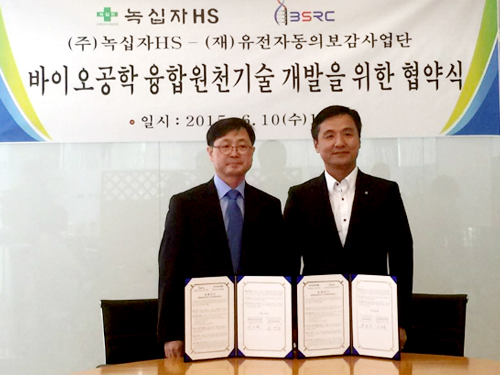 KAIST to support the Genetic Donguibogam Research Project for global market entry of a new natural drug produced by Green Cross Corporation HS
In the wake of the spread of the Middle East Respiratory Syndrome (MERS), sales of immune-enhancing products in Korea such as red and white ginseng have risen dramatically. Ginseng is one of Korea’s major health supplement it exports, but due to the lack of precise scientific knowledge of its mechanism, sales of ginseng account for less than 2% of the global market share.
The Genetic Donguibogam Research Project represents a group of research initiatives to study genes and environmental factors that contribute to diseases and to discover alternative treatments through Eastern medicine. The project is being led by KAIST’s Department of Bio & Brain Engineering Professor Do-Heon Lee.
Professor Lee and Chief Executive Officer Young-Hyo Yoo of Green Cross Corporation HS, a Korean pharmaceutical company, signed a memorandum of understanding (MOU), as well as a non-disclosure agreement (NDA) to develop a naturally derived drug with an enhanced ginsenoside, pharmacological compounds of ginseng, for the global market entry of BST204 on June 10, 2015.
Donguibogam is the traditional Korean source for the principles and practice of Eastern medicine, which was compiled by the royal physician Heo Jun and first published in 1613 during the Joseon Dynasty of Korea.
Cooperating with Green Cross Co., HS, KAIST researchers will use a multi-component, multi-target (MCMT)-based development platform to produce the new natural drug, BST204. This cooperation is expected to assist the entry of the drug into the European market.
Green Cross Co., HS has applied a bio-conversion technique to ginseng to develop BST204, which is a drug with enhanced active constituent of aginsenosides. The drug is the first produced by any Korean pharmaceutical company to complete the first phase of clinical trials in Germany and is about to start the second phase of trials.
Professor Do-Heon Lee, the Director of the project said, “Genetic Donguibogam Research Project seeks to create new innovative healthcare material for the future using integrated fundamental technologies such as virtual human body computer modelling and multi-omics to explain the mechanism in which natural ingredients affect the human body.” He continued, “Especially, by employing the virtual human body computer modelling, we can develop an innovative new technology that will greatly assist Korean pharmaceutical industry and make it the platform technology in entering global markets.”
Young-Hyo Yoo, the CEO of Green Cross Co., HS, said, “For a new naturally derived drug to be acknowledged in the global market, such as Europe and the US, its mechanism, as well as its effectiveness and safety, should be proven. However, it is difficult and costly to explain the mechanism in which the complex composition of a natural substance influences the body. Innovative technology is needed to solve this problem.”
Professor Do-Heon Lee (left in the picture), the Director of Genetic Donguibogam Research Project, stands abreast Young-Hyo Yoo (right in the picture), the CEO of Green Cross Co., HS.
2015.06.10 View 8846
KAIST to support the Genetic Donguibogam Research Project for global market entry of a new natural drug produced by Green Cross Corporation HS
In the wake of the spread of the Middle East Respiratory Syndrome (MERS), sales of immune-enhancing products in Korea such as red and white ginseng have risen dramatically. Ginseng is one of Korea’s major health supplement it exports, but due to the lack of precise scientific knowledge of its mechanism, sales of ginseng account for less than 2% of the global market share.
The Genetic Donguibogam Research Project represents a group of research initiatives to study genes and environmental factors that contribute to diseases and to discover alternative treatments through Eastern medicine. The project is being led by KAIST’s Department of Bio & Brain Engineering Professor Do-Heon Lee.
Professor Lee and Chief Executive Officer Young-Hyo Yoo of Green Cross Corporation HS, a Korean pharmaceutical company, signed a memorandum of understanding (MOU), as well as a non-disclosure agreement (NDA) to develop a naturally derived drug with an enhanced ginsenoside, pharmacological compounds of ginseng, for the global market entry of BST204 on June 10, 2015.
Donguibogam is the traditional Korean source for the principles and practice of Eastern medicine, which was compiled by the royal physician Heo Jun and first published in 1613 during the Joseon Dynasty of Korea.
Cooperating with Green Cross Co., HS, KAIST researchers will use a multi-component, multi-target (MCMT)-based development platform to produce the new natural drug, BST204. This cooperation is expected to assist the entry of the drug into the European market.
Green Cross Co., HS has applied a bio-conversion technique to ginseng to develop BST204, which is a drug with enhanced active constituent of aginsenosides. The drug is the first produced by any Korean pharmaceutical company to complete the first phase of clinical trials in Germany and is about to start the second phase of trials.
Professor Do-Heon Lee, the Director of the project said, “Genetic Donguibogam Research Project seeks to create new innovative healthcare material for the future using integrated fundamental technologies such as virtual human body computer modelling and multi-omics to explain the mechanism in which natural ingredients affect the human body.” He continued, “Especially, by employing the virtual human body computer modelling, we can develop an innovative new technology that will greatly assist Korean pharmaceutical industry and make it the platform technology in entering global markets.”
Young-Hyo Yoo, the CEO of Green Cross Co., HS, said, “For a new naturally derived drug to be acknowledged in the global market, such as Europe and the US, its mechanism, as well as its effectiveness and safety, should be proven. However, it is difficult and costly to explain the mechanism in which the complex composition of a natural substance influences the body. Innovative technology is needed to solve this problem.”
Professor Do-Heon Lee (left in the picture), the Director of Genetic Donguibogam Research Project, stands abreast Young-Hyo Yoo (right in the picture), the CEO of Green Cross Co., HS.
2015.06.10 View 8846 -
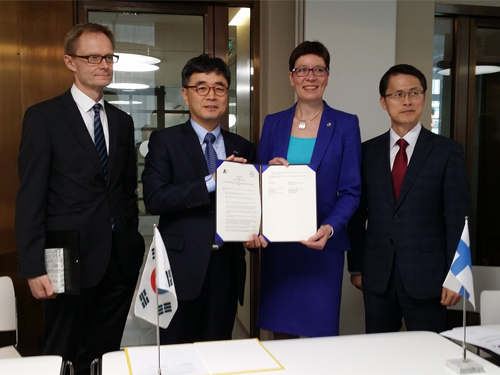 KAIST to Kick-Start the Exchange of Young Researchers with Northern European Universities
KAIST promotes research exchange and cooperation with three universities in Northern Europe.
KAIST has signed a letter of intent (LOI) for the mutual exchange of young researchers and cooperation to collaborate with KTH Royal Institute of Technology and Lund University, both based in Sweden on June 2, 2015, and with Aalto University in Finland on June 4, 2015.
This LOI was the result of the cooperative projects of Korea-Sweden and Korea-Finland Joint Committees on Science and Technology supervised by the Ministry of Science, ICT and Future Planning of Korea.
As agreed in the LOI, KAIST will conduct joint research projects with the three universities by providing students and researchers with opportunities to visit each other through internship programs and workshops and by sharing information on education and research.
Sung-Hyon Mayeng, the Associate Vice President of the International Relations Office at KAIST, said, “It’s an encouraging sign that universities and governments recognize the importance of increasing exchanges among academic and research communities. Expecting more vibrant relationships to be formed between KAIST and the three northern European universities in coming years, I hope that today’s agreement becomes a good basis to spur technological innovations that will not only benefit the regions but also the world.”
Established in 1827, the KTH Royal Institute of Technology is the largest and oldest technical university in Sweden, accounting for one-third of the nation’s technical research and engineering education capacity at university level. The university offers education and research programs from natural sciences to all branches of engineering including architecture, industrial management, and urban planning. According to the QS World University Rankings in 2014, KTH Royal Institute of Technology ranked 27th in engineering and 1st in Northern Europe.
Lund University, Sweden, is one of the oldest and most prestigious universities in northern Europe, consistently ranking among the world’s top 100 universities. In particular, its biological sciences and engineering have shown great strength, placing within the top 60 universities by the Times Higher Education (THE) World University Rankings. The university also receives the largest amount of research funding from the Swedish government.
Aalto University in Finland was created as a merger of three leading Finnish universities: the Helsinki University of Technology (established 1849), the Helsinki School of Economics (established 1904), and the University of Art and Design Helsinki (established 1871). The university nurtures the close collaborations across science, business, and arts to foster multi-disciplinary education and research.
2015.06.04 View 8427
KAIST to Kick-Start the Exchange of Young Researchers with Northern European Universities
KAIST promotes research exchange and cooperation with three universities in Northern Europe.
KAIST has signed a letter of intent (LOI) for the mutual exchange of young researchers and cooperation to collaborate with KTH Royal Institute of Technology and Lund University, both based in Sweden on June 2, 2015, and with Aalto University in Finland on June 4, 2015.
This LOI was the result of the cooperative projects of Korea-Sweden and Korea-Finland Joint Committees on Science and Technology supervised by the Ministry of Science, ICT and Future Planning of Korea.
As agreed in the LOI, KAIST will conduct joint research projects with the three universities by providing students and researchers with opportunities to visit each other through internship programs and workshops and by sharing information on education and research.
Sung-Hyon Mayeng, the Associate Vice President of the International Relations Office at KAIST, said, “It’s an encouraging sign that universities and governments recognize the importance of increasing exchanges among academic and research communities. Expecting more vibrant relationships to be formed between KAIST and the three northern European universities in coming years, I hope that today’s agreement becomes a good basis to spur technological innovations that will not only benefit the regions but also the world.”
Established in 1827, the KTH Royal Institute of Technology is the largest and oldest technical university in Sweden, accounting for one-third of the nation’s technical research and engineering education capacity at university level. The university offers education and research programs from natural sciences to all branches of engineering including architecture, industrial management, and urban planning. According to the QS World University Rankings in 2014, KTH Royal Institute of Technology ranked 27th in engineering and 1st in Northern Europe.
Lund University, Sweden, is one of the oldest and most prestigious universities in northern Europe, consistently ranking among the world’s top 100 universities. In particular, its biological sciences and engineering have shown great strength, placing within the top 60 universities by the Times Higher Education (THE) World University Rankings. The university also receives the largest amount of research funding from the Swedish government.
Aalto University in Finland was created as a merger of three leading Finnish universities: the Helsinki University of Technology (established 1849), the Helsinki School of Economics (established 1904), and the University of Art and Design Helsinki (established 1871). The university nurtures the close collaborations across science, business, and arts to foster multi-disciplinary education and research.
2015.06.04 View 8427 -
 The Acoustical Society of America Names Yang Hann Kim of KAIST the Recipient of the 2015 Rossing Prize in Acoustics Education
The award, given to Dr. Kim in recognition of his contributions to the advancement of acoustics education, will be presented during the 170th Meeting of the Acoustical Society of America on November 2-6, 2015 in Jacksonville, Florida.
The Acoustical Society of America (ASA) announced today that Professor Yang Hann Kim of the Mechanical Engineering Department at the Korea Advanced Institute of Science and Technology (KAIST) was the 12th recipient of the Rossing Prize in Acoustics Education. Dr. Kim is the first recipient selected from a non-English-speaking nation.
The Rossing Prize in Acoustics Education was established in 2003 from a generous gift made to the ASA Foundation by Thomas D. Rossing to recognize an individual who has made significant contributions to the advancement of acoustics education through distinguished teaching, creation of educational materials, textbook writing, and other activities.
During 25 years of teaching and conducting research in acoustics, noise, and vibration at KAIST, Dr. Kim has advised 26 doctorates and published over 200 research papers in journals such as Journal of Acoustical Society of America, Journal of Sound and Vibration, and Journal of Mechanical Systems and Signal Processing. He also wrote two acoustics textbooks for university education, which has been widely read worldwide. The textbook titles are: Sound Propagation: An Impedance Based Approach (Wiley, July 2010) and with the co-author, Dr. Jung-Woo Choi, Sound Visualization and Manipulation (Wiley, September 2013).
Since 2009, Professor Kim has lectured an online course entitled “Introduction to Acoustics,” offering students and the general public throughout the world guidance to study acoustics through the basic concept of impedance, for example, on vibrations and waves.
Dr. Kim will receive the award during ASA’s 170th conference to be held on November 2-6, 2015 at the Hyatt Regency Jacksonville Riverfront Hotel in Jacksonville, Florida, USA.
For the list of previous recipients of the Rossing Prize in Acoustics Education,
see:http://acousticalsociety.org/funding_resources/prizes#rossing
2015.06.04 View 9012
The Acoustical Society of America Names Yang Hann Kim of KAIST the Recipient of the 2015 Rossing Prize in Acoustics Education
The award, given to Dr. Kim in recognition of his contributions to the advancement of acoustics education, will be presented during the 170th Meeting of the Acoustical Society of America on November 2-6, 2015 in Jacksonville, Florida.
The Acoustical Society of America (ASA) announced today that Professor Yang Hann Kim of the Mechanical Engineering Department at the Korea Advanced Institute of Science and Technology (KAIST) was the 12th recipient of the Rossing Prize in Acoustics Education. Dr. Kim is the first recipient selected from a non-English-speaking nation.
The Rossing Prize in Acoustics Education was established in 2003 from a generous gift made to the ASA Foundation by Thomas D. Rossing to recognize an individual who has made significant contributions to the advancement of acoustics education through distinguished teaching, creation of educational materials, textbook writing, and other activities.
During 25 years of teaching and conducting research in acoustics, noise, and vibration at KAIST, Dr. Kim has advised 26 doctorates and published over 200 research papers in journals such as Journal of Acoustical Society of America, Journal of Sound and Vibration, and Journal of Mechanical Systems and Signal Processing. He also wrote two acoustics textbooks for university education, which has been widely read worldwide. The textbook titles are: Sound Propagation: An Impedance Based Approach (Wiley, July 2010) and with the co-author, Dr. Jung-Woo Choi, Sound Visualization and Manipulation (Wiley, September 2013).
Since 2009, Professor Kim has lectured an online course entitled “Introduction to Acoustics,” offering students and the general public throughout the world guidance to study acoustics through the basic concept of impedance, for example, on vibrations and waves.
Dr. Kim will receive the award during ASA’s 170th conference to be held on November 2-6, 2015 at the Hyatt Regency Jacksonville Riverfront Hotel in Jacksonville, Florida, USA.
For the list of previous recipients of the Rossing Prize in Acoustics Education,
see:http://acousticalsociety.org/funding_resources/prizes#rossing
2015.06.04 View 9012 -
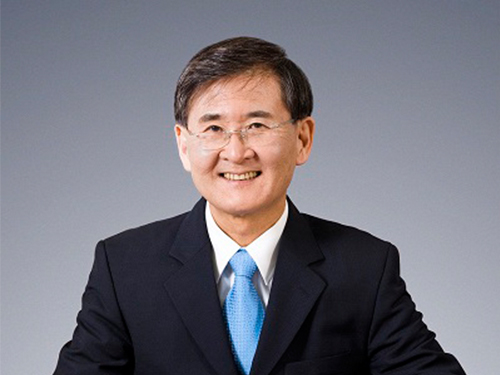 President Steve Kang Receives the John Choma Education Award from the IEEE International Symposium on Circuits and Systems
The Institute of Electrical and Electronics Engineers (IEEE) International Symposium on Circuits and Systems (ISCAS) 2015 took place at the Cultural Centre of Belem in Lisbon, Portugal, on May 24-27, 2015.
President Steve Kang attended the conference and presented a paper entitled “Memrister-based Synapses and Neurons for Neuromorphic Computing” on May 26, 2015. On the same day, he received the John Choma Education Award.
The award was established to commemorate the lifetime achievement of the late Professor John Choma of the Electrical Engineering Department at the University of Southern California. Dr. Choma was an eminent scientist, scholar, and educator, who earned global recognition in the field of integrated circuits and very-large-scale-integration (VLSI).
The IEEE ISCAS selects, among its members, the recipient of the John Choma Education Award, who has made significant contributions to the education of circuits and systems.
President Kang advised 60 doctorates while teaching at the University of Illinois at Urbana-Champaign and the University of California at Santa Cruz and published 450 research papers in the past 40 years. He also received Meritorious Service Award, Charles Desoer Technical Achievement Award, and Mac Van Valkenburg Society Award, all from the IEEE ISCAS.
2015.06.03 View 7060
President Steve Kang Receives the John Choma Education Award from the IEEE International Symposium on Circuits and Systems
The Institute of Electrical and Electronics Engineers (IEEE) International Symposium on Circuits and Systems (ISCAS) 2015 took place at the Cultural Centre of Belem in Lisbon, Portugal, on May 24-27, 2015.
President Steve Kang attended the conference and presented a paper entitled “Memrister-based Synapses and Neurons for Neuromorphic Computing” on May 26, 2015. On the same day, he received the John Choma Education Award.
The award was established to commemorate the lifetime achievement of the late Professor John Choma of the Electrical Engineering Department at the University of Southern California. Dr. Choma was an eminent scientist, scholar, and educator, who earned global recognition in the field of integrated circuits and very-large-scale-integration (VLSI).
The IEEE ISCAS selects, among its members, the recipient of the John Choma Education Award, who has made significant contributions to the education of circuits and systems.
President Kang advised 60 doctorates while teaching at the University of Illinois at Urbana-Champaign and the University of California at Santa Cruz and published 450 research papers in the past 40 years. He also received Meritorious Service Award, Charles Desoer Technical Achievement Award, and Mac Van Valkenburg Society Award, all from the IEEE ISCAS.
2015.06.03 View 7060 -
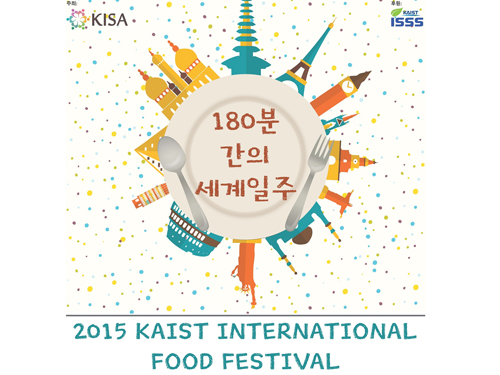 KAIST International Food Festival
The KAIST International Students Association (KISA) hosted the 2015 International Food Festival in front of Creative Learning Building, KAIST, on May 22, 2015.
This was the 11th International Food Festival for KAIST where international students introduced food from their home countries to strengthen cultural exchanges with Korean students. This year’s festival was the biggest international festival in Daejeon in which around 500 students and staff from KAIST, Chungnam National University (CNU), the University of Science & Technology (UST), and the public participated.
KAIST’s President Steve Kang opened the festival with a welcoming speech, followed by congratulatory speeches by CNU President Sang-Chul Jung and UST President Un-Woo Lee.
The first section of the event was the food festival where around 40 kinds of food from ten countries including Kenya, Kazakhstan, India, and Turkey were presented. Students from each country offered cooking demonstrations in booths, and participants purchased the food.
Cheryl Wanderi, a Kenyan student who recently received a Master’s degree from KAIST’s Department of Bio and Brain Engineering last February said, “I am delighted to introduce Mandazi, a Kenyan donut, to not only Korean students but also other international students.”
The second half of the event consisted of cultural performances from different countries. There were eight teams performing including an Indonesian traditional Saman dance team, a Kazakh group that performed on traditional instruments, and an Azerbaijani K-POP dance team.
Sung-Hyon Myaeng, the Associate Vice President of KAIST’s International Office, said, “Despite their busy lives, students from three different universities planned this event to get to know each other. I hope international students and Korean students can come together and enjoy the festival.”
Edrick Kwek, the President of KISA, said, “This food festival is an event showing the cultural diversity of KAIST in the most splendid way.”
2015.05.27 View 9859
KAIST International Food Festival
The KAIST International Students Association (KISA) hosted the 2015 International Food Festival in front of Creative Learning Building, KAIST, on May 22, 2015.
This was the 11th International Food Festival for KAIST where international students introduced food from their home countries to strengthen cultural exchanges with Korean students. This year’s festival was the biggest international festival in Daejeon in which around 500 students and staff from KAIST, Chungnam National University (CNU), the University of Science & Technology (UST), and the public participated.
KAIST’s President Steve Kang opened the festival with a welcoming speech, followed by congratulatory speeches by CNU President Sang-Chul Jung and UST President Un-Woo Lee.
The first section of the event was the food festival where around 40 kinds of food from ten countries including Kenya, Kazakhstan, India, and Turkey were presented. Students from each country offered cooking demonstrations in booths, and participants purchased the food.
Cheryl Wanderi, a Kenyan student who recently received a Master’s degree from KAIST’s Department of Bio and Brain Engineering last February said, “I am delighted to introduce Mandazi, a Kenyan donut, to not only Korean students but also other international students.”
The second half of the event consisted of cultural performances from different countries. There were eight teams performing including an Indonesian traditional Saman dance team, a Kazakh group that performed on traditional instruments, and an Azerbaijani K-POP dance team.
Sung-Hyon Myaeng, the Associate Vice President of KAIST’s International Office, said, “Despite their busy lives, students from three different universities planned this event to get to know each other. I hope international students and Korean students can come together and enjoy the festival.”
Edrick Kwek, the President of KISA, said, “This food festival is an event showing the cultural diversity of KAIST in the most splendid way.”
2015.05.27 View 9859 -
 KAIST and Audi Korea Sign a Memorandum of Understanding to Establish a Startup Incubator
For the next five years, Audi Korea will provide USD 250,000 for the startup program.
KAIST recently signed a memorandum of understanding (MOU) with Audi Korea to establish a student-led startup program, the Audi-KAIST Innovation Lounge, to promote design and product development on May 19, 2015, at the KAIST Institute of Entrepreneurship on campus.
Directed by Professor Sang-Min Bae of the Industrial Design Department (IDD), the Audi-KAIST Innovation Lounge will operate a global business incubator where IDD undergraduate and graduate students cultivate their entrepreneurship skills and explore business opportunities to develop commercially-applicable product designs. Audi Korea will invest USD 250,000 in the Innovation Lounge project for the next five years.
Students will receive support from the Lounge to turn their ideas, class assignments, and graduation theses into business products through a full cycle of the product development process such as inquiry, prototype development, and commercialization. The Lounge will also provide students with mentoring services from industry professionals and experts who can assist the students in finding design solutions and building prototypes using 3D printers.
The Dean of IDD, Kun-Pyo Lee, said, “Audi has been known for its initiatives which blend technological innovations into design. Likewise, our department offers students an integrative approach to design education and research which incorporates human factors and technology as important features in the design process. I believe that the Audi-KAIST Innovation Lounge will help us lead such efforts in the future.”
Professor Bae added, “This MOU is quite significant because it shows an excellent collaboration between academia and industry. Ideas created in universities should not be left to languish as just an idea or research. Rather, they should be utilized as ways to serve the needs of our society, and to do so, it is important for the government and companies to pay more attention to these interactions taking place between academia and private sectors.”
The Head of Marketing at Audi Korea, Jorg Dietzel, said, “As seen in our corporate slogan, "Advancement through Technology," Audi has grown through numerous technological innovations. I hope Audi Korea can contribute to the support of KAIST students from the Industrial Design Department to realize their dreams as future entrepreneurs and bring more innovative ideas to their field.”
Picture: Jorg Dietzel (fifth from the left), the Head of Marketing at Audi Korea, and Kun-Pyo Lee (sixth from the left), the Dean of Industrial Design Department, KAIST, pose together right after signing an agreement to create the Audi-KAIST Innovation Lounge on May 19, 2015.
2015.05.22 View 9540
KAIST and Audi Korea Sign a Memorandum of Understanding to Establish a Startup Incubator
For the next five years, Audi Korea will provide USD 250,000 for the startup program.
KAIST recently signed a memorandum of understanding (MOU) with Audi Korea to establish a student-led startup program, the Audi-KAIST Innovation Lounge, to promote design and product development on May 19, 2015, at the KAIST Institute of Entrepreneurship on campus.
Directed by Professor Sang-Min Bae of the Industrial Design Department (IDD), the Audi-KAIST Innovation Lounge will operate a global business incubator where IDD undergraduate and graduate students cultivate their entrepreneurship skills and explore business opportunities to develop commercially-applicable product designs. Audi Korea will invest USD 250,000 in the Innovation Lounge project for the next five years.
Students will receive support from the Lounge to turn their ideas, class assignments, and graduation theses into business products through a full cycle of the product development process such as inquiry, prototype development, and commercialization. The Lounge will also provide students with mentoring services from industry professionals and experts who can assist the students in finding design solutions and building prototypes using 3D printers.
The Dean of IDD, Kun-Pyo Lee, said, “Audi has been known for its initiatives which blend technological innovations into design. Likewise, our department offers students an integrative approach to design education and research which incorporates human factors and technology as important features in the design process. I believe that the Audi-KAIST Innovation Lounge will help us lead such efforts in the future.”
Professor Bae added, “This MOU is quite significant because it shows an excellent collaboration between academia and industry. Ideas created in universities should not be left to languish as just an idea or research. Rather, they should be utilized as ways to serve the needs of our society, and to do so, it is important for the government and companies to pay more attention to these interactions taking place between academia and private sectors.”
The Head of Marketing at Audi Korea, Jorg Dietzel, said, “As seen in our corporate slogan, "Advancement through Technology," Audi has grown through numerous technological innovations. I hope Audi Korea can contribute to the support of KAIST students from the Industrial Design Department to realize their dreams as future entrepreneurs and bring more innovative ideas to their field.”
Picture: Jorg Dietzel (fifth from the left), the Head of Marketing at Audi Korea, and Kun-Pyo Lee (sixth from the left), the Dean of Industrial Design Department, KAIST, pose together right after signing an agreement to create the Audi-KAIST Innovation Lounge on May 19, 2015.
2015.05.22 View 9540 -
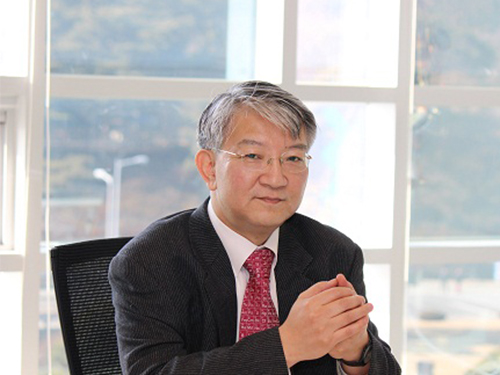 Professor Sang-Yup Lee Receives the Order of Service Merit Red Stripes from the Korean Government
The government of the Republic of Korea named Professor Sang-Yup Lee of the Department of Chemical and Bio-molecular Engineering at KAIST as the fiftieth recipient of the Order of Service Merit Red Stripes on May 19, 2015.
This medal is awarded to government employees, officials, and teachers in recognition of their contributions to public services including education.
Professor Lee is regarded as a leading scientist in the field of metabolic engineering, genomics, proteomics, metabolomics, and bioinformatics on microorganism producing various primary and secondary metabolites. He contributed significantly to the advancement of bio-based engineering research in Korea.
In addition, his research in microorganism metabolic engineering propelled him to the front of his field, making him the world’s founder of systems metabolic engineering, inventing numerous technologies in strain development.
Professor Lee has received many patent rights in bioprocess engineering. While at KAIST, he applied for 585 patents and registered 227 patents. In particular, he has applied for 135 patents and registered 99 patents in the past five years, successfully turning research results into commercial applications.
Professor Lee said, “I’m glad to contribute to the development of Korean science and technology as a researcher and teacher. I would like to share this honor with my students, master’s and doctoral students in particular, because without their support, it wouldn’t have been possible to pull off the highest level of research results recognized by this medal.”
2015.05.21 View 8317
Professor Sang-Yup Lee Receives the Order of Service Merit Red Stripes from the Korean Government
The government of the Republic of Korea named Professor Sang-Yup Lee of the Department of Chemical and Bio-molecular Engineering at KAIST as the fiftieth recipient of the Order of Service Merit Red Stripes on May 19, 2015.
This medal is awarded to government employees, officials, and teachers in recognition of their contributions to public services including education.
Professor Lee is regarded as a leading scientist in the field of metabolic engineering, genomics, proteomics, metabolomics, and bioinformatics on microorganism producing various primary and secondary metabolites. He contributed significantly to the advancement of bio-based engineering research in Korea.
In addition, his research in microorganism metabolic engineering propelled him to the front of his field, making him the world’s founder of systems metabolic engineering, inventing numerous technologies in strain development.
Professor Lee has received many patent rights in bioprocess engineering. While at KAIST, he applied for 585 patents and registered 227 patents. In particular, he has applied for 135 patents and registered 99 patents in the past five years, successfully turning research results into commercial applications.
Professor Lee said, “I’m glad to contribute to the development of Korean science and technology as a researcher and teacher. I would like to share this honor with my students, master’s and doctoral students in particular, because without their support, it wouldn’t have been possible to pull off the highest level of research results recognized by this medal.”
2015.05.21 View 8317 -
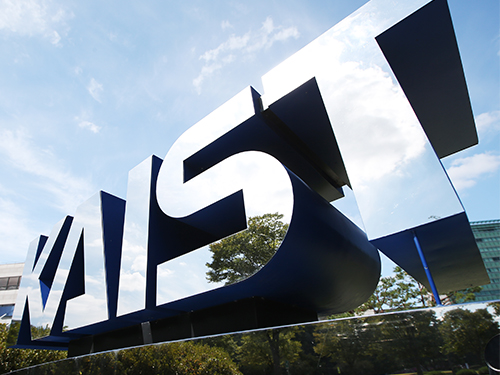 KAIST to Host Conference on the Financial Technology Industry
To take place in the Korea Federation of Banks building on May 21, 2015, Seoul
Around 200 individuals to be present including Oh-Kyu Kwon, the former Minister of Finance and Economy and Chang-Hyun Yun, the former president of Korea Institute of Finance
KAIST will hold a conference to discuss prospects for Korea’s financial technology industry (FinTech) and to address the rapid changes taking place in both national and global finance markets.
The conference will be held in the Convention Hall of the Korea Federation of Banks building in Myeongdong, Seoul on May 21, 2015 with a theme entitled “The Challenge and the Task of Korean FinTech Industry in the Global Finance Market.”
Around 200 individuals including Oh-Kyu Kwon, the former Minister of Finance and Economy, Jiwon Jung, a member of a standing committee of Financial Services Commission, and Steve Kang, the President of KAIST will attend the meeting.
The term “FinTech” originates from the combination of two words, finance and technology, to describe a new form of financial system based on Information Technology (IT). The precise definition and boundary of FinTech is not fully established yet, but this will provide Korea with an opportunity to take the lead in the finance industry with its cutting-edge IT.
The conference will focus on the methods by which Korean FinTech companies can acquire a competitive edge in the global finance market. The keynote speaker, Tong-Suk Kim, the Dean of College of Business, KAIST, will speak about “The Challenge and the Task of Korean FinTech.” The talk will emphasize how the FinTech industry can create an innovative industry, destroying the existing paradigm of payment system and Internet-only banks.
The keynote speech will be followed by a talk on “The Requirements for Establishing Korean FinTech Ecosystem” by Jong-Hyun Kim, a researcher at Woori Finance Research Institute, Korea.
Additional talks, which will be given by KAIST professors, are:
“Korean Economy and the Role of FinTech” by Professor Young-Sun Kwon of the Department Business and Technology Management;
“Korean FinTech in ICT Perspective” by Professor Yoon-Joon Lee of the Department of Computer Science;
“The Current State and Possibilities of Korean FinTech” by Professor Byung-Tae Lee of the School of Management Engineering; and
“The Task and Challenge of Promoting FinTech Industry” by Professor Byung-Chun Kim of the School of Management Engineering.
Also, Professor Chang-Hyun Yoon of the School of Business Administration, University of Seoul, will give a talk on “The Crisis in Korean Finance Industry and the Role of FinTech.”
The conference will also hold a discussion session on “The Promotion Methods for Korean FinTech Industry.” Participants for the discussion will include Jae-Sung Song from the Ministry of Science, ICT and Future Planning, Dong-Hwan Kim from the Financial Services Commission, Jeon Jin from Samsung Economic Research Institute (SERI), Hyo-Jin Lee of 8Percent, In-Chang Hwang from the Korea Insurance Research Institute, and Jae-Kyu Lee from Koscom.
Byung-Chun Kim, the Director of KAIST’s Financial Engineering Research Center, who organized the FinTech conference said, “FinTech industry will evolve from simply attempting to attract consumers to understanding the lifestyle patterns of consumers to provide customized service and information.”
2015.05.20 View 9707
KAIST to Host Conference on the Financial Technology Industry
To take place in the Korea Federation of Banks building on May 21, 2015, Seoul
Around 200 individuals to be present including Oh-Kyu Kwon, the former Minister of Finance and Economy and Chang-Hyun Yun, the former president of Korea Institute of Finance
KAIST will hold a conference to discuss prospects for Korea’s financial technology industry (FinTech) and to address the rapid changes taking place in both national and global finance markets.
The conference will be held in the Convention Hall of the Korea Federation of Banks building in Myeongdong, Seoul on May 21, 2015 with a theme entitled “The Challenge and the Task of Korean FinTech Industry in the Global Finance Market.”
Around 200 individuals including Oh-Kyu Kwon, the former Minister of Finance and Economy, Jiwon Jung, a member of a standing committee of Financial Services Commission, and Steve Kang, the President of KAIST will attend the meeting.
The term “FinTech” originates from the combination of two words, finance and technology, to describe a new form of financial system based on Information Technology (IT). The precise definition and boundary of FinTech is not fully established yet, but this will provide Korea with an opportunity to take the lead in the finance industry with its cutting-edge IT.
The conference will focus on the methods by which Korean FinTech companies can acquire a competitive edge in the global finance market. The keynote speaker, Tong-Suk Kim, the Dean of College of Business, KAIST, will speak about “The Challenge and the Task of Korean FinTech.” The talk will emphasize how the FinTech industry can create an innovative industry, destroying the existing paradigm of payment system and Internet-only banks.
The keynote speech will be followed by a talk on “The Requirements for Establishing Korean FinTech Ecosystem” by Jong-Hyun Kim, a researcher at Woori Finance Research Institute, Korea.
Additional talks, which will be given by KAIST professors, are:
“Korean Economy and the Role of FinTech” by Professor Young-Sun Kwon of the Department Business and Technology Management;
“Korean FinTech in ICT Perspective” by Professor Yoon-Joon Lee of the Department of Computer Science;
“The Current State and Possibilities of Korean FinTech” by Professor Byung-Tae Lee of the School of Management Engineering; and
“The Task and Challenge of Promoting FinTech Industry” by Professor Byung-Chun Kim of the School of Management Engineering.
Also, Professor Chang-Hyun Yoon of the School of Business Administration, University of Seoul, will give a talk on “The Crisis in Korean Finance Industry and the Role of FinTech.”
The conference will also hold a discussion session on “The Promotion Methods for Korean FinTech Industry.” Participants for the discussion will include Jae-Sung Song from the Ministry of Science, ICT and Future Planning, Dong-Hwan Kim from the Financial Services Commission, Jeon Jin from Samsung Economic Research Institute (SERI), Hyo-Jin Lee of 8Percent, In-Chang Hwang from the Korea Insurance Research Institute, and Jae-Kyu Lee from Koscom.
Byung-Chun Kim, the Director of KAIST’s Financial Engineering Research Center, who organized the FinTech conference said, “FinTech industry will evolve from simply attempting to attract consumers to understanding the lifestyle patterns of consumers to provide customized service and information.”
2015.05.20 View 9707 -
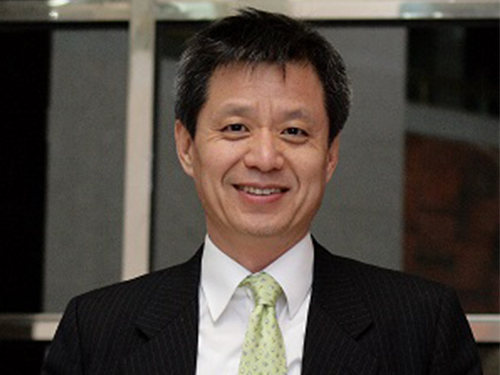 Professor Duck-Joo Lee Is Elected Vice Chairman of the American Helicopter Society
Professor Duck-Joo Lee of the Department of Aerospace Engineering at KAIST was elected to become the first Korean vice president of the American Helicopter Society (AHS). He will serve a two-year term, starting this July, and his responsibilities will cover Asia, Australia, and Russia.
AHS, established in 1943, is the biggest association in the field with 6,800 members. The society is intended to advance helicopter technology and vertical take-off and landing (VTOL) in airplane technology.
The AHS’s board of directors consists of thirty experts in rotorcrafts, including the president of Sikorsky Aircraft Corporation, a renowned American helicopter manufacturing company.
Professor Lee started his career as a researcher in NASA Ames Research Center in the United States, and is now an acknowledged scholar in the field of aircraft jet engines and helicopter Aero-Acoustics. He also worked as the Assistant Editor-in-Chief of Journal of the American Helicopter Society, the President of the first Asia-Australia Rotorcraft Forum, and the leader of National Task Force Team of Korean Military and Civil Helicopter.
2015.05.18 View 8239
Professor Duck-Joo Lee Is Elected Vice Chairman of the American Helicopter Society
Professor Duck-Joo Lee of the Department of Aerospace Engineering at KAIST was elected to become the first Korean vice president of the American Helicopter Society (AHS). He will serve a two-year term, starting this July, and his responsibilities will cover Asia, Australia, and Russia.
AHS, established in 1943, is the biggest association in the field with 6,800 members. The society is intended to advance helicopter technology and vertical take-off and landing (VTOL) in airplane technology.
The AHS’s board of directors consists of thirty experts in rotorcrafts, including the president of Sikorsky Aircraft Corporation, a renowned American helicopter manufacturing company.
Professor Lee started his career as a researcher in NASA Ames Research Center in the United States, and is now an acknowledged scholar in the field of aircraft jet engines and helicopter Aero-Acoustics. He also worked as the Assistant Editor-in-Chief of Journal of the American Helicopter Society, the President of the first Asia-Australia Rotorcraft Forum, and the leader of National Task Force Team of Korean Military and Civil Helicopter.
2015.05.18 View 8239 -
 KAIST Hosts the Wearable Computer Contest 2015
Deadlines for Prototype Contest by May 30, 2015 and August 15 for Idea Contest
KAIST will hold the Wearable Computer Contest 2015 in November, which will be sponsored by Samsung Electronics Co., Ltd.
Wearable computers have emerged as next-generation mobile devices, and are gaining more popularity with the growth of the Internet of Things. KAIST has introduced wearable devices such as K-Glass 2, a smart glass with augmented reality embedded. The Glass also works on commands by blinking eyes.
This year’s contest with the theme of “Wearable Computers for Internet of Things” is divided into two parts: the Prototype Competition and Idea Contest.
With the fusion of information technology (IT) and fashion, contestants are encouraged to submit prototypes of their ideas by May 30, 2015. The ten teams that make it to the finals will receive a wearable computer platform and Human-Computer Interaction (HCI) education, along with a prize of USD 1,000 for prototype production costs. The winner of the Prototype Contest will receive a prize of USD 5,000 and an award from the Minister of Science, ICT and Future Planning (MSIP) of the Republic of Korea.
In the Idea Contest, posters containing ideas and concepts of wearable devices should be submitted by August 15, 2015. The teams that make it to the finals will have to display a life-size mockup in the final stage. The winner of the contest will receive a prize of USD 1,000 and an award from the Minister of MSIP.
Any undergraduate or graduate student in Korea can enter the Prototype Competition and anyone can participate in the Idea Contest.
The chairman of the event, Hoi-Jun Yoo, a professor of the Department of Electrical Engineering at KAIST, noted:
“There is a growing interest in wearable computers in the industry. I can easily envisage that there will be a new IT world where wearable computers are integrated into the Internet of Things, healthcare, and smart homes.”
More information on the contest can be found online at http://www.ufcom.org.
Picture: Finalists in the last year’s contest
2015.05.11 View 8082
KAIST Hosts the Wearable Computer Contest 2015
Deadlines for Prototype Contest by May 30, 2015 and August 15 for Idea Contest
KAIST will hold the Wearable Computer Contest 2015 in November, which will be sponsored by Samsung Electronics Co., Ltd.
Wearable computers have emerged as next-generation mobile devices, and are gaining more popularity with the growth of the Internet of Things. KAIST has introduced wearable devices such as K-Glass 2, a smart glass with augmented reality embedded. The Glass also works on commands by blinking eyes.
This year’s contest with the theme of “Wearable Computers for Internet of Things” is divided into two parts: the Prototype Competition and Idea Contest.
With the fusion of information technology (IT) and fashion, contestants are encouraged to submit prototypes of their ideas by May 30, 2015. The ten teams that make it to the finals will receive a wearable computer platform and Human-Computer Interaction (HCI) education, along with a prize of USD 1,000 for prototype production costs. The winner of the Prototype Contest will receive a prize of USD 5,000 and an award from the Minister of Science, ICT and Future Planning (MSIP) of the Republic of Korea.
In the Idea Contest, posters containing ideas and concepts of wearable devices should be submitted by August 15, 2015. The teams that make it to the finals will have to display a life-size mockup in the final stage. The winner of the contest will receive a prize of USD 1,000 and an award from the Minister of MSIP.
Any undergraduate or graduate student in Korea can enter the Prototype Competition and anyone can participate in the Idea Contest.
The chairman of the event, Hoi-Jun Yoo, a professor of the Department of Electrical Engineering at KAIST, noted:
“There is a growing interest in wearable computers in the industry. I can easily envisage that there will be a new IT world where wearable computers are integrated into the Internet of Things, healthcare, and smart homes.”
More information on the contest can be found online at http://www.ufcom.org.
Picture: Finalists in the last year’s contest
2015.05.11 View 8082 -
 Professor Jinwoo Shin Receives the Bloomberg Scientific Research Award
Professor Jinwoo Shin (https://sites.google.com/site/mijirim/) of the Electrical Engineering Department at KAIST has been selected as one of the three winners to receive the first Bloomberg Scientific Research Award this month. The newly created award is presented to researchers in computer science who conduct high-quality research in such areas as machine learning, natural language processing, machine translation, statistics, and theory.
Professor Shin submitted his research proposal entitled “Scalable Probabilistic Deep Leaning,” and the award will support funding his research for one year. For details, please click on the link below for an article released by Bloomberg News, announcing the winners of the award:
Bloomberg News, April 28, 2015
“Announcing the Winners of the Bloomberg’s First Scientific Research Program”
https://3blmedia.com/News/Announcing-Winners-Bloombergs-First-Scientific-Research-Program
2015.04.30 View 8115
Professor Jinwoo Shin Receives the Bloomberg Scientific Research Award
Professor Jinwoo Shin (https://sites.google.com/site/mijirim/) of the Electrical Engineering Department at KAIST has been selected as one of the three winners to receive the first Bloomberg Scientific Research Award this month. The newly created award is presented to researchers in computer science who conduct high-quality research in such areas as machine learning, natural language processing, machine translation, statistics, and theory.
Professor Shin submitted his research proposal entitled “Scalable Probabilistic Deep Leaning,” and the award will support funding his research for one year. For details, please click on the link below for an article released by Bloomberg News, announcing the winners of the award:
Bloomberg News, April 28, 2015
“Announcing the Winners of the Bloomberg’s First Scientific Research Program”
https://3blmedia.com/News/Announcing-Winners-Bloombergs-First-Scientific-Research-Program
2015.04.30 View 8115 -
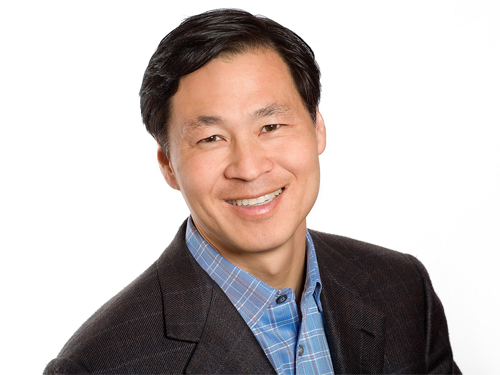 Jong Hoon Kim, a former president of Bell Labs, speaks at KAIST
Dr. Jong-Hoon Kim, who was the youngest person to serve as the President of Bell Labs and selected as one of the ten most influential Asian-Americans, will give a lecture at KAIST at 5 pm on April 28, 2015 in the KI building.
In 1992, Dr. Kim founded a telecommunication company, Yurie System. After listing the company on NASDAQ, he sold the company to Lucent Technologies for USD one billion. Dr. Kim served as the President of Lucent Technologies, taught as the University of Maryland, and subsequently served as the President of Bell Labs. He is currently the President of Kiswe Mobile.
In his lecture entitled “Aim High, Take Action,” Dr. Kim will share his personal stories and speak about ways young people can set goals for future and put those into practice. He will focus on his experiences in the United States to list his own company, Yurie System, on NASDAQ and to sell the company as well as the management innovations, which he brought about during his presidency at Bell Labs.
KAIST and Kiswe Mobile have been cooperating on a project, "Global Entrepreneurship by Doing," since 2014 to foster entrepreneurship in Korean youth. While working for Kiswe Mobile in the United States, KAIST students will have an opportunity to conduct project management, market research, and marketing, and to build local networks.
The details of the program can be found on the website of the KAIST Center for Science-based Entrepreneurship, http://eship.kaist.ac.kr.
2015.04.27 View 6188
Jong Hoon Kim, a former president of Bell Labs, speaks at KAIST
Dr. Jong-Hoon Kim, who was the youngest person to serve as the President of Bell Labs and selected as one of the ten most influential Asian-Americans, will give a lecture at KAIST at 5 pm on April 28, 2015 in the KI building.
In 1992, Dr. Kim founded a telecommunication company, Yurie System. After listing the company on NASDAQ, he sold the company to Lucent Technologies for USD one billion. Dr. Kim served as the President of Lucent Technologies, taught as the University of Maryland, and subsequently served as the President of Bell Labs. He is currently the President of Kiswe Mobile.
In his lecture entitled “Aim High, Take Action,” Dr. Kim will share his personal stories and speak about ways young people can set goals for future and put those into practice. He will focus on his experiences in the United States to list his own company, Yurie System, on NASDAQ and to sell the company as well as the management innovations, which he brought about during his presidency at Bell Labs.
KAIST and Kiswe Mobile have been cooperating on a project, "Global Entrepreneurship by Doing," since 2014 to foster entrepreneurship in Korean youth. While working for Kiswe Mobile in the United States, KAIST students will have an opportunity to conduct project management, market research, and marketing, and to build local networks.
The details of the program can be found on the website of the KAIST Center for Science-based Entrepreneurship, http://eship.kaist.ac.kr.
2015.04.27 View 6188